Better Conditions, Better Business
Attachments

Table of Contents
- Executive Summary
- Introduction
- About the survey
- Carer and family friendly provisions
- The availability of carer and family friendly provisions in Australian SMEs
- The usage of carer and family friendly provisions in Australian SMEs
- Carer and family friendly provisions by demographic
- The benefits of carer and family friendly provisions
- The drawbacks of carer and family friendly provisions
- Barriers to SMEs offering carer and family friendly provisions
- The impact of carer and family friendly provisions on business performance
- Caring responsibilities of SME operators
- Carer and family friendly provisions for staff attraction and retention
- How SMEs provide carer and family friendly provisions
- Part-time work
- Working from home
- Job-sharing
- Flexible annual leave
- The ability to purchase additional annual leave
- Flexible start and finish times
- Paid parental leave
- Unpaid parental leave
- Paid adoption leave
- Unpaid adoption leave
- Carers leave to care for children
- Carers leave to care for another family member
- Unpaid emergency leave for casual employees
- Access to a telephone for family reasons
- The ability to bring children to work in an emergency
- The ability to bring an older person or person with a disability to work in an emergency
- Subsidy for child care
- Subsidy for elder care or care for a family member with a disability
- On-site child care
- Conclusion
This work is copyright. You may download, display, print and reproduce this material in unaltered form only (retaining this notice) for your personal, non-commercial use or use within your organisation. Apart from any use as permitted under the Copyright Act 1968, all other rights are reserved. Requests and inquiries concerning reproduction and rights should be addressed to the Commonwealth Copyright Administration, Attorney-General's Department, Robert Garran Offices, National Circuit, Barton ACT 2600 or posted to http://www.ag.gov.au
DISCLAIMER: Sensis® prepared the information in this publication about carer and family friendly provisions in Australian small and medium enterprises. It draws on information, opinions and advice provided by a variety of individuals and organisations, including the Commonwealth of Australia. The Commonwealth accepts no responsibility for the accuracy or completeness of any material contained in this publication. Additionally, the Commonwealth disclaims all liability to any person in respect of anything, and of the consequences of anything, done or omitted to be done by any such person in reliance, whether wholly or partially, upon any information presented in this publication.
CAUTION: Material in this publication is made available on the understanding that the Commonwealth is not providing professional advice. Before relying on any of the material in this publication, users should obtain appropriate professional advice. Views and recommendations which may also be included in this publication are those of the author, Sensis®, only, and do not necessarily refl ect the views of the Commonwealth, the Minister Assisting the Prime Minister for Women's Issues, or the Department of Families, Community Services and Indigenous Affairs or indicate a commitment to a particular course of action.
DATA: Tables and charts in this publication by Sensis® Business Index, Sweeney Research—February 2006
Executive Summary
Overview of the report
This report examines the availability and take-up of family friendly provisions within Australian small and medium enterprises (SMEs). It draws upon survey data from the Sensis® Business Index, which surveys 1,800 small and medium enterprise (SME) operators. For this survey, additional questions were asked covering 19 specific carer and family friendly provisions, as well as providing businesses with the opportunity to discuss other provisions they offered, the impact and potential impact of skills shortages on their businesses, and their ability to change working provisions to attract and retain quality employees.
The provision of carer and family friendly provisions in Australian SMEs
In summary, the survey found that 97 per cent of SMEs provided at least one provision to their employees to assist them in balancing their work and caring responsibilities. Overall, the types of provisions varied in the extent to which they were offered by SMEs, however the provisions most likely to be offered by businesses to their employees were access to a telephone for family reasons, which was offered by 87 per cent of SMEs; fl exible annual leave allowing employees to choose the timing of leave and the ability to take single days, which was offered by 83 per cent of SMEs; and fl exible start and finish times, which were offered by 73 per cent of SMEs.
When looking at the usage of provisions by employees, the same three provisions were also the most used provisions. The rate at which provisions that were offered by SMEs were taken up by their employees was highest for these three provisions. It is interesting to note that the provision with the fourth highest take-up rate by employees was the ability to work from home, which was taken up in 83 per cent of the 30 per cent of businesses in which it was offered.
When looking at business demographics, medium businesses with 20 to 199 employees tended to be more likely to offer carer and family friendly provisions than smaller businesses with up to 19 employees. It was interesting to note that family businesses tended to offer most provisions at lower rates than other businesses. Home-based businesses were no more likely to offer fl exible provisions than other businesses, with the notable exceptions of on-site child care and the ability for their employees to also work from home.
Gender, of both the business operators and the employees, was found to play a quite important role in the availability and take-up of carer and family friendly provisions. Businesses that were predominantly operated by females were more likely than other businesses to offer carer and family friendly provisions to their employees. The only provisions that were more likely to be offered by SMEs that were predominantly male-operated were the ability to work from home and the ability to purchase additional annual leave.
Whilst the gender of the operator was important, the gender of the employees played an even larger role. Almost all provisions were more likely to be offered in businesses whose workforce was predominantly female.
When examining how carer and family friendly provisions were provided in Australian SMEs, the overwhelming method was through unwritten informal agreements, with formal mechanisms such as awards, human resources policies, Australian Workplace Agreements (AWAs) and collective workplace agreements being used by relatively minor proportions of SMEs by comparison.
The impact of carer and family friendly provisions
Overall, the study found an overwhelmingly positive impact for businesses that provided their employees with carer and family friendly provisions. Four in five SME operators felt that providing such provisions had a positive benefit for their business, with the most likely benefit being the ability to keep their employees happy. Drawbacks of providing fl exible provisions were much smaller in magnitude, with loss of productive time and increased costs being identified as the main drawbacks. Some 42 per cent of SMEs felt that there were no drawbacks in providing carer and family friendly provisions to their employees. Likewise the main barrier or difficulty in offering carer and family friendly provisions was the cost involved, which was nominated by 23 per cent of SME operators.
In addition to the reported benefits that providing carer and family friendly provisions were seen to bring, businesses that offered these provisions also reported higher levels of business performance, in particular in sales and profitability, when compared to businesses that did not offer any provisions to their employees.
It is important to note that SME operators often have caring responsibilities themselves. Some 33 per cent of SME operators reported that they have caring responsibilities, with 63 per cent of those reporting that their caring responsibilities affected how they ran their businesses. For many this meant having to either curtail their business to fit around their caring responsibilities, or trying to fit both business and family responsibilities around each other.
Finally, the impact of skills shortages was investigated, with over one quarter of SMEs anticipating that skills shortages would impact on their business in the next twelve months. Providing fl exible working arrangements was seen to have potential to assist SMEs, with some 57 per cent stating that they would be willing to change their working arrangements to obtain or retain skilled employees.
About the Sensis® Business Index
The Sensis® Business Index is an ongoing series of surveys designed to track confidence and behaviour of small and medium enterprises (SMEs). Since its inception in 1993, the Sensis® Business Index has been one of the most extensive and regular surveys of small businesses in Australia. Historically, the Sensis® Business Index has focused specifically on businesses employing 19 people or fewer. In November 2000 it was expanded to cover the medium business sector, while the regional and industrial sectors were also enhanced.
The primary objectives of the Sensis® Business Index are to track small and medium business activity over the past three months; expectations over both the next three and 12 months; and to measure overall confidence within the small business community. A second purpose is to provide an independent, objective channel for reporting proprietors' experience and attitudes on key issues.
The Sensis® Business Index enables broad scrutiny of the SME market, as well as an understanding of trends and issues relevant to this sector. It examines the differences in attitudes and experiences between regional and metropolitan SMEs, and between small and medium enterprises. The aim of the Sensis® Business Index is to refl ect the attitudes and behaviour of approximately 99 per cent of the Australian business sector.
The Sensis® Business Index is based on a sample size of 1,800 SMEs from metropolitan and regional areas of Australia. It includes businesses within the accommodation, construction, communication, health, community services, cultural and recreational industries.
Introduction
This report, prepared by Sensis®, was commissioned by the Office for Women, Australian Government, Department of Families, Community Services and Indigenous Affairs as part of the Australian Government's Women's Leadership and Development Program. The report looks at the availability and take-up of carer and family friendly provisions within Australian small and medium enterprises (SMEs). Carer and family friendly provisions enable employees to combine their work and family responsibilities. This is particularly important for women, who are more likely to have primary responsibility for child care and are more likely to have other caring responsibilities such as elder care or care for a person with a disability. In the past, significant emphasis has been placed on the availability of family friendly provisions in large businesses. However, as SMEs are also significant employers, it is important to consider the extent to which they offer family friendly provisions to their employees. In this context, the report looks at the various ways in which SMEs assist employees to balance their caring responsibilities with work and whether these provisions are offered as part of a formal arrangement such as an award or on an informal basis. The report also looks at the benefits and drawbacks identified by SMEs offering family-friendly working arrangements.
About the survey
The February 2006 Sensis® Business Index results are based on telephone interviews conducted with 1,800 small and medium business proprietors. The sample size is divided between 1,400 small businesses and 400 medium businesses (the latter defined as businesses employing between 20 and 199 people). It is important to remember that not all small businesses employ staff. Questions in this survey that relate to employment provisions were only asked of those SMEs that did have employees. Other questions that were not employment dependent, for example those relating to the business operator’s family and caring responsibilities, were asked of all business operators, regardless of whether or not they had employees.
Businesses interviewed for the February 2006 Sensis® Business Index were drawn from all metropolitan and major non-metropolitan regions within Australia. Quotas were set on geographical location and type of business in order to produce the standard sample structure shown opposite. Where replacement businesses are recruited, this sample structure is maintained.
At the analysis stage, results were weighted by selected Australian New Zealand Standard Industrial Classification (ANZSIC) divisions within the metropolitan and non-metropolitan region of each state and territory. This ensured the sample refl ected the actual small and medium business population distribution. The Australian Bureau of Statistics (ABS) Business Register, as at June 1998, was used to weight the sample to be representative of the total business population.
The Sensis® Business Index asks whether there is more than one predominant decision-maker in the business. Where there is only one predominant decision-maker, the survey records the gender of that decision-maker. Where there is more than one predominant decision-maker in the business, the survey records whether the predominant gender is female, male or an equal joint mix of female and male operators. In the February 2006 Sensis® Business Index, 13 per cent of the SMEs in the weighted sample were predominantly operated by females, with 71 per cent predominantly operated by males, and 16 per cent being operated by both males and females as equal joint decision-makers, as shown in Chart 1.
In addition, the survey asks about many aspects of the business and the operators, and this information is used where relevant in the analysis. In particular, respondents are asked whether they consider their business to be a family business. A rigid definition is not used for this question. Business operators are also asked whether they operate their business primarily out of their home, or out of a business premises. Home-based businesses are then further stratified to determine whether they operate their business “at the home” or “from the home”, with home-based businesses in this report including both of these groups. Interviewing for this survey was conducted over the period 18 January to 8 February 2006.
| State | Total | Metro | Non-metro |
|---|---|---|---|
| New South Wales | 300 | 240 | 60 |
| Victoria | 300 | 240 | 60 |
| Queensland | 300 | 165 | 135 |
| South Australia | 225 | 195 | 30 |
| Western Australia | 225 | 195 | 30 |
| Tasmania | 150 | 90 | 60 |
| Northern Territory | 150 | 90 | 60 |
| Australian Capital Territory | 150 | 150 | - |
| Total | 1800 | 1365 | 435 |
| Manufacturing | 200 |
| Building/construction | 250 |
| Wholesale trade | 150 |
| Retail trade | 250 |
| Accommodation, cafes and restaurants | 100 |
| Transport/storage | 150 |
| Finance and insurance | 100 |
| Communication, property and business services | 150 |
| Health and community services | 150 |
| Cultural, recreational and personal services | 150 |
| Total | 1800 |
Carer and family friendly provisions
- The availability of carer and family friendly provisions in Australian SMEs
- The usage of carer and family friendly provisions in Australian SMEs
- Carer and family friendly provisions by demographic
- The benefits of carer and family friendly provisions
- The drawbacks of carer and family friendly provisions
- Barriers to SMEs offering carer and family friendly provisions
- The impact of carer and family friendly provisions on business performance
- Caring responsibilities of SME operators
- Carer and family friendly provisions for staff attraction and retention
The availability of carer and family friendly provisions in Australian SMEs
This report aims to provide a snapshot of how small and medium enterprises use flexible working practices in their businesses, how their employees use these provisions, and the impact that they have had on their businesses. This snapshot uses data from the Sensis® Business Index to capture the attitudes of Australian business operators to carer and family friendly provisions in February 2006.
The availability of carer and family friendly provisions in Australian SMEs should be considered in the context of Australian legislative requirements as set out in the Australian Fair Pay and Conditions Standard in the Workplace Relations Act 1996. By law, no workplace agreement or contract can provide conditions which are less than those in the Standard.
The Standard provides for a maximum of 52 weeks of unpaid parental leave, shared between both parents at the time of the birth of a child or the adoption of a child under five years of age. The parental leave provisions apply to full-time, part-time and eligible casual employees with at least 12 months of continuous service with their current employer. The Standard also provides ten days paid personal/carer's leave per year, with casual employees or employees who have not accrued sick leave able to access two days unpaid "emergency" leave.

Note: percentages represent proportions of the total weighted sample of the Sensis® Business Index
When examining the impact of flexible working practices in SMEs, it is important to take into consideration the fact that the vast majority of businesses in Australia are small. Estimates put the proportion of SMEs in the Australian business population at over 99 per cent of all private sector businesses1.
By its very nature this creates a working environment often quite different to what is encountered in a large organisation. The results of this research show that SMEs are often able to respond quite flexibly to their employees' family and caring responsibilities.
As can be seen in Chart 2, only three per cent of SMEs offered no flexible working provisions to their employees.

This survey asked SMEs specifically about how they approached offering and providing a range of 19 initiatives, which can be seen in Chart 2. In addition, SME operators were able to outline any additional initiatives that they provided to their employees. The interesting point to note at the outset is that SMEs have a high amount of flexibility in terms of the provisions that they are able to offer their employees. SME operators provided many examples of other initiatives that were outside the standard range of carer and family friendly initiatives. Some examples of these initiatives are shown in Chart 3, and illustrate the broad range of practical measures and benefits that SME operators provide to help their employees balance work and family, ranging from health insurance to internet access to time off in lieu.
Chart 3: Other provisions provided by SMEs
- Staff loans
- Ability to cash in leave
- Counselling services
- Open door policy—work through issues/problems together
- Bonus incentives
- Time in lieu
- Cars/transport available
- Rostered days off
- Payment for studies/training
- Bereavement leave
- Meals/allowance provided
- Extra insurances provided e.g. health
- Free use of equipment/staff discounts
- Internet access
The usage of carer and family friendly provisions in Australian SMEs
Whilst the previous section showed the extent to which SMEs in Australia offered provisions to their employees to assist them balancing their caring responsibilities, this section looks at the extent to which these provisions are actually used by employees.
It can be seen by comparing Chart 5 with Chart 4 that there is sometimes considerable difference between the provisions that businesses offer to employees and the rate at which these are taken up.
Chart 5 shows that the top three provisions offered by SMEs were also the top three provisions likely to be used by their employees: access to a telephone for family reasons; flexible annual leave; and flexible start and finish times. However, it is not surprising that the provisions most commonly offered are those most likely to be used, as businesses are more likely to offer provisions relevant to their staff.
To gain an idea of the relative popularity of provisions, it Chart 4: Carer and family friendly provisions currently offered is interesting to examine the relative take-up rates within those businesses that offer them, that is the proportion of businesses that have had those provisions used in the last twelve months. Table 1 compares the take up of provisions with the offering of provisions. From this table it can be seen that flexible start and finish times is the provision that is most likely to be taken up by employees if it is offered by a business—some 96 per cent of businesses that offered flexible start and finish times reported having employees using them. Again, access to a telephone for family reasons and flexible annual leave were all relatively well taken up by employees. Working from home, while only offered in 30 per cent of SMEs was taken up in 83 per cent of SMEs offering it. Another provision that was taken up in high levels in those SMEs that offered it was on-site child care, which while only offered in five per cent of SMEs was taken up in 60 per cent of those offering it. At the other end of the scale, while subsidies for elder care were reported as offered in two per cent of SMEs, the uptake of this option was negligible.


| Offered | Used in the last 12 months | Take-up rate | |
| Flexible start/finish times | 73% | 70% | 96% |
| Access to a telephone for family reasons | 87% | 81% | 93% |
| Flexible annual leave (e.g. With respect to timing and use of single days) | 83% | 73% | 88% |
| Working from home | 30% | 25% | 83% |
| Part-time work | 61% | 43% | 70% |
| Ability to bring child/ren to work in an emergency | 60% | 37% | 62% |
| On-site child care | 5% | 3% | 60% |
| Job-sharing | 40% | 24% | 60% |
| Carers leave to care for children | 42% | 22% | 52% |
| Unpaid emergency leave for casual employees | 51% | 25% | 49% |
| Ability to purchase additional annual leave | 31% | 14% | 45% |
| Carers leave to care for another family member (e.g. Partner, parent, adult child with a disability) | 47% | 20% | 43% |
| Subsidy for child care | 5% | 2% | 40% |
| Paid parental leave | 19% | 6% | 32% |
| Unpaid parental leave | 44% | 14% | 32% |
| Paid adoption leave | 9% | 1% | 11% |
| Ability to bring an older person or person with a disability to work in an emergency | 44% | 5% | 11% |
| Unpaid adoption leave | 22% | 1% | 5% |
| Subsidy for elder care or care for a family member with a disability | 2% | 0% | 0% |
| Q. I'm going to read out some provisions that businesses offer to their employees to help them balance their family and caring responsibilities with their work. Do you offer the following carer and family friendly provisions to your employees? Which of these provisions have any of your employees used in the last 12 months? | |||


Carer and family friendly provisions by demographic
This section looks at some of the differences in carer and family friendly provisions by various demographics, in particular business size, family businesses, home-based businesses, the gender of the operator (or predominant gender of the operators in the case of multiple operators), and the predominant gender of the employees. Tables outlining the results for specific demographics are provided in the following pages.
Business size (Tables 2 and 3)
Overall, medium businesses were more likely to offer their employees carer and family friendly provisions. Some four per cent of small businesses did not offer any flexible provisions to their employees, whilst the proportion of medium businesses that offered no provisions was negligible.
Whilst most provisions were more likely to be offered by medium businesses, there were some exceptions. Small businesses were more likely to allow their employees to bring children or elders to work in an emergency, and they were also more likely to offer on-site child care than their medium counterparts. The other provision that was more likely to be offered by small businesses was the ability to purchase additional annual leave.
Medium businesses were particularly more likely to offer their employees parental, adoption and carers leave than small businesses.
Interestingly, in terms of uptake of provisions, there was no provision that employees of small businesses were more likely to take up than those in medium businesses.
Family businesses (Table 4)
Family businesses were, in general, marginally less likely to provide carer and family friendly provisions to their employees than businesses that were not family-based. The only provisions that were more likely to be offered by family businesses were subsidies for elder care; on-site child care; and the ability to purchase additional annual leave.
Paid parental leave and subsidies for child care were equally likely to be provided by both family and non-family businesses. All other provisions were more likely to be provided by non-family businesses.
Looking at the take-up of provisions, employees of family businesses were generally less likely to utilise most provisions in comparison with employees of non-family businesses. The exceptions to this were paid and unpaid adoption leave; the ability to bring children to work in emergencies; and the ability to purchase additional annual leave, which were all used by a higher percentage of employees in family businesses. The ability to bring elders to work in emergencies and on-site child care were used by equal percentages of employees in both family businesses and non-family businesses.
Home-based businesses (Table 5)
In general, home-based businesses were no more likely to offer carer and family friendly provisions than businesses that were operated from separate business premises. However there were three areas that homebased businesses were more likely to offer benefits in than businesses that were not home-based. Firstly, the proportion of home-based businesses that offered on-site child care was double the proportion of non-home-based businesses, indicating that this provision might be more easily provided in a home-based working environment.
| Offer | Used in last 12 months | |
|---|---|---|
| Paid parental leave | 18% | 5% |
| Unpaid parental leave | 42% | 12% |
| Paid adoption leave | 8% | 0% |
| Unpaid adoption leave | 21% | 1% |
| Carers leave to care for children | 40% | 20% |
| Carers leave to care for another family member (e.g. partner, parent, adult child with a disability) | 46% | 18% |
| Unpaid emergency leave for casual employees | 50% | 24% |
| Access to a telephone for family reasons | 86% | 81% |
| Ability to bring child/ren to work in an emergency | 60% | 36% |
| Ability to bring an older person or person with a disability to work in an emergency | 44% | 5% |
| Subsidy for child care | 5% | 2% |
| Subsidy for elder care or care for a family member with a disability | 2% | 0% |
| On-site child care | 6% | 3% |
| Part-time work | 60% | 42% |
| Working from home | 29% | 24% |
| Job-sharing | 39% | 24% |
| Flexible annual leave (e.g. with respect to timing and use of single days) | 83% | 72% |
| Ability to purchase additional annual leave | 31% | 14% |
| Flexible start/finish times | 73% | 69% |
| Q. I'm going to read out some provisions that businesses offer to their employees to help them balance their family and caring responsibilities with their work. Do you offer the following carer and family friendly provisions to your employees? Which of these provisions have any of your employees used in the last 12 months? | ||
| Offer | Used in last 12 months | |
|---|---|---|
| Paid parental leave | 39% | 27% |
| Unpaid parental leave | 76% | 44% |
| Paid adoption leave | 19% | 1% |
| Unpaid adoption leave | 37% | 2% |
| Carers leave to care for children. | 63% | 50% |
| Carers leave to care for another family member (e.g. partner, parent, adult child with a disability) | 63% | 43% |
| Unpaid emergency leave for casual employees | 58% | 34% |
| Access to a telephone for family reasons | 94% | 90% |
| Ability to bring child/ren to work in an emergency | 57% | 47% |
| Ability to bring an older person or person with a disability to work in an emergency | 41% | 6% |
| Subsidy for child care | 8% | 4% |
| Subsidy for elder care or care for a family member with a disability | 3% | 0% |
| On-site child care | 5% | 4% |
| Part-time work | 71% | 60% |
| Working from home | 42% | 39% |
| Job-sharing | 44% | 32% |
| Flexible annual leave (e.g. with respect to timing and use of single days) | 91% | 86% |
| Ability to purchase additional annual leave | 29% | 16% |
| Flexible start/finish times | 77% | 73% |
| Q. I'm going to read out some provisions that businesses offer to their employees to help them balance their family and caring responsibilities with their work. Do you offer the following carer and family friendly provisions to your employees? Which of these provisions have any of your employees used in the last 12 months? | ||
| Offer | Used in last 12 months | |
|---|---|---|
| Paid parental leave | 19% | 4% |
| Unpaid parental leave | 41% | 10% |
| Paid adoption leave | 8% | 1% |
| Unpaid adoption leave | 20% | 1% |
| Carers leave to care for children. | 39% | 18% |
| Carers leave to care for another family member (e.g. partner, parent, adult child with a disability) | 44% | 17% |
| Unpaid emergency leave for casual employees | 48% | 22% |
| Access to a telephone for family reasons | 85% | 80% |
| Ability to bring child/ren to work in an emergency | 57% | 37% |
| Ability to bring an older person or person with a disability to work in an emergency | 42% | 5% |
| Subsidy for child care | 5% | 2% |
| Subsidy for elder care or care for a family member with a disability | 3% | 0% |
| On-site child care | 6% | 3% |
| Part-time work | 60% | 41% |
| Working from home | 29% | 23% |
| Job-sharing | 39% | 23% |
| Flexible annual leave (e.g. with respect to timing and use of single days) | 83% | 72% |
| Flexible annual leave (e.g. with respect to timing and use of single days) | 33% | 16% |
| Flexible start/finish times | 71% | 69% |
| Q. I'm going to read out some provisions that businesses offer to their employees to help them balance their family and caring responsibilities with their work. Do you offer the following carer and family friendly provisions to your employees? Which of these provisions have any of your employees used in the last 12 months? | ||
| Offer | Used in last 12 months | |
|---|---|---|
| Paid parental leave | 13% | 1% |
| Unpaid parental leave | 41% | 11% |
| Paid adoption leave | 10% | 1% |
| Unpaid adoption leave | 21% | 2% |
| Carers leave to care for children. | 35% | 10% |
| Carers leave to care for another family member (e.g. partner, parent, adult child with a disability) | 46% | 13% |
| Unpaid emergency leave for casual employees | 43% | 14% |
| Access to a telephone for family reasons | 72% | 68% |
| Ability to bring child/ren to work in an emergency | 48% | 22% |
| Ability to bring an older person or person with a disability to work in an emergency | 38% | 5% |
| Subsidy for child care | 3% | 0% |
| Subsidy for elder care or care for a family member with a disability | 3% | 0% |
| On-site child care | 9% | 3% |
| Part-time work | 63% | 38% |
| Working from home | 44% | 37% |
| Job-sharing | 39% | 19% |
| Flexible annual leave (e.g. with respect to timing and use of single days) | 76% | 58% |
| Ability to purchase additional annual leave | 31% | 10% |
| Flexible start/finish times | 76% | 71% |
| Q. I'm going to read out some provisions that businesses offer to their employees to help them balance their family and caring responsibilities with their work. Do you offer the following carer and family friendly provisions to your employees? Which of these provisions have any of your employees used in the last 12 months? | ||
Secondly, homebased businesses were significantly more likely to offer their employees the ability to work from home. In addition, flexible start and finish times were significantly more likely to be offered by home-based businesses. Other provisions that were offered by a higher proportion of home-based businesses were paid adoption leave; subsidies for elder care; parttime work; and the ability to purchase additional annual leave. All other provisions were more likely to be offered by businesses operating from separate business premises.
In terms of the use of provisions, employees of home-based businesses were more likely to utilise paid and unpaid adoption leave; subsidies for elder care; working from home; and flexible start and finish times than employees of businesses that were not home-based.
Gender of predominant decision-maker (Tables 6, 7 and 8)
Overall, businesses which had predominantly female decision-makers were more likely than other businesses to provide carer and family friendly provisions for their employees. This was followed by businesses with equal joint female and male decision-makers, with those businesses with predominantly male decision-makers being the least likely to offer most carer and family friendly provisions to their employees.
Those businesses that were predominantly operated by females were most likely to provide unpaid emergency leave for casual employees; access to a telephone for family reasons; ability to bring children or elders to work in emergencies; subsidies for child care; on-site child care; part-time work; job sharing; flexible annual leave and flexible start and finish times for their employees. They were also equally most likely, along with businesses that had equal joint female and male decision-makers, to provide their employees with unpaid parental leave; carers leave to care for children; and subsidies for elder or disabled care.
| Offer | Used in last 12 months | |
|---|---|---|
| Paid parental leave | 16% | 7% |
| Unpaid parental leave | 48% | 17% |
| Paid adoption leave | 7% | 1% |
| Unpaid adoption leave | 25% | 3% |
| Carers leave to care for children. | 47% | 29% |
| Carers leave to care for another family member (e.g. partner, parent, adult child with a disability) | 49% | 22% |
| Unpaid emergency leave for casual employees | 62% | 40% |
| Access to a telephone for family reasons | 92% | 90% |
| Ability to bring child/ren to work in an emergency | 66% | 45% |
| Ability to bring an older person or person with a disability to work in an emergency | 54% | 14% |
| Subsidy for child care | 7% | 5% |
| Subsidy for elder care or care for a family member with a disability | 3% | 2% |
| On-site child care | 15% | 14% |
| Part-time work | 73% | 64% |
| Working from home | 27% | 24% |
| Job-sharing | 53% | 46% |
| Flexible annual leave (e.g. with respect to timing and use of single days) | 86% | 83% |
| Ability to purchase additional annual leave | 31% | 20% |
| Flexible start/finish times | 77% | 73% |
| Q. I'm going to read out some provisions that businesses offer to their employees to help them balance their family and caring responsibilities with their work. Do you offer the following carer and family friendly provisions to your employees? Which of these provisions have any of your employees used in the last 12 months? | ||
| Offer | Used in last 12 months | |
|---|---|---|
| Paid parental leave | 19% | 6% |
| Unpaid parental leave | 43% | 15% |
| Paid adoption leave | 8% | 1% |
| Unpaid adoption leave | 20% | 1% |
| Carers leave to care for children. | 40% | 20% |
| Carers leave to care for another family member (e.g. partner, parent, adult child with a disability) | 45% | 19% |
| Unpaid emergency leave for casual employees | 49% | 22% |
| Access to a telephone for family reasons | 87% | 81% |
| Ability to bring child/ren to work in an emergency | 59% | 34% |
| Ability to bring an older person or person with a disability to work in an emergency | 42% | 5% |
| Subsidy for child care | 5% | 2% |
| Subsidy for elder care or care for a family member with a disability | 2% | 0% |
| On-site child care | 5% | 1% |
| Part-time work | 59% | 40% |
| Working from home | 31% | 26% |
| Job-sharing | 35% | 19% |
| Flexible annual leave (e.g. with respect to timing and use of single days) | 82% | 74% |
| Ability to purchase additional annual leave | 32% | 14% |
| Flexible start/finish times | 73% | 70% |
| Q. I'm going to read out some provisions that businesses offer to their employees to help them balance their family and caring responsibilities with their work. Do you offer the following carer and family friendly provisions to your employees? Which of these provisions have any of your employees used in the last 12 months? | ||
| Offer | Used in last 12 months | |
|---|---|---|
| Paid parental leave | 24% | 7% |
| Unpaid parental leave | 48% | 11% |
| Paid adoption leave | 16% | 0% |
| Unpaid adoption leave | 28% | 0% |
| Carers leave to care for children. | 47% | 25% |
| Carers leave to care for another family member (e.g. partner, parent, adult child with a disability) | 52% | 22% |
| Unpaid emergency leave for casual employees | 50% | 30% |
| Access to a telephone for family reasons | 82% | 77% |
| Ability to bring child/ren to work in an emergency | 58% | 43% |
| Ability to bring an older person or person with a disability to work in an emergency | 44% | 3% |
| Subsidy for child care | 6% | 3% |
| Subsidy for elder care or care for a family member with a disability | 3% | 0% |
| On-site child care | 3% | 3% |
| Part-time work | 63% | 42% |
| Working from home | 25% | 21% |
| Job-sharing | 51% | 35% |
| Flexible annual leave (e.g. with respect to timing and use of single days) | 84% | 64% |
| Ability to purchase additional annual leave | 26% | 11% |
| Flexible start/finish times | 69% | 67% |
| Q. I'm going to read out some provisions that businesses offer to their employees to help them balance their family and caring responsibilities with their work. Do you offer the following carer and family friendly provisions to your employees? Which of these provisions have any of your employees used in the last 12 months? | ||
Those businesses with equal joint female and male decision-makers were the next most likely to provide their employees with carer and family friendly provisions. The provisions that these businesses were more likely to provide than other businesses included paid parental leave; paid and unpaid adoption leave; and carers leave to care for other family members.
While still providing a significant range of provisions to assist their employees to balance their work and family responsibilities, businesses that were predominantly operated by males were least likely to provide their employees with carer and family friendly provisions. There were only two categories of provisions that these businesses were more likely to provide than businesses that were either predominantly operated by females or with equal joint male and female decision-makers: the ability to work from home; and the ability to purchase additional annual leave.
When examining the use of provisions by employees it is interesting to note that businesses that were predominantly female-operated reported either the highest or equal highest proportions of employees taking up the provisions they offered. The only exception to this was working from home, which was more likely to be utilised by employees in businesses predominantly operated by males.
Predominant gender of employees (Tables 9, 10 and 11)
While the gender of the operator of the business was seen to have some impact on whether the business offered carer and family friendly provisions to its employees, it was found that the predominant gender of the employees of a business had a much larger effect.
In almost all cases, businesses whose employees were predominantly female were more likely than other businesses to offer carer and family friendly provisions to their employees. This was the case for all provisions with the exception of on-site child care, which was most likely to be offered by businesses with equal proportions of female and male employees; and the ability to purchase additional annual leave, which was more likely to be offered in businesses with predominantly male employees.
Businesses with predominantly female employees were not only more likely to offer carer and family friendly provisions, they also reported the highest take-up rate.
Businesses with predominantly female employees were more likely than other businesses to report usage of paid and unpaid parental leave; carers leave to care for children and other family members; unpaid emergency leave for casual employees; access to a telephone for family reasons; the ability to bring children and elders to work in an emergency; subsidies for child and elder care; on-site child care; part-time work; working from home; job sharing; flexible annual leave; and flexible start and finish times. They were equally likely, along with businesses with predominantly male employees, to use paid adoption leave.
Businesses with equally balanced proportions of male and female employees were more likely to report usage of unpaid adoption leave, whilst businesses with predominantly male employees were more likely to report usage of staff purchasing additional annual leave in the past twelve months.
| Offer | Used in last 12 months | |
|---|---|---|
| Paid parental leave | 25% | 8% |
| Unpaid parental leave | 60% | 16% |
| Paid adoption leave | 15% | 1% |
| Unpaid adoption leave | 32% | 1% |
| Carers leave to care for children. | 53% | 31% |
| Carers leave to care for another family member (e.g. partner, parent, adult child with a disability) | 54% | 24% |
| Unpaid emergency leave for casual employees | 62% | 37% |
| Access to a telephone for family reasons | 90% | 85% |
| Ability to bring child/ren to work in an emergency | 73% | 52% |
| Ability to bring an older person or person with a disability to work in an emergency | 55% | 8% |
| Subsidy for child care | 8% | 4% |
| Subsidy for elder care or care for a family member with a disability | 5% | 1% |
| On-site child care | 9% | 7% |
| Part-time work | 74% | 61% |
| Working from home | 32% | 28% |
| Job-sharing | 53% | 36% |
| Flexible annual leave (e.g. with respect to timing and use of single days) | 86% | 75% |
| Ability to purchase additional annual leave | 31% | 14% |
| Flexible start/finish times | 75% | 70% |
| Q. I'm going to read out some provisions that businesses offer to their employees to help them balance their family and caring responsibilities with their work. Do you offer the following carer and family friendly provisions to your employees? Which of these provisions have any of your employees used in the last 12 months? | ||
| Offer | Used in last 12 months | |
|---|---|---|
| Paid parental leave | 17% | 6% |
| Unpaid parental leave | 37% | 13% |
| Paid adoption leave | 7% | 1% |
| Unpaid adoption leave | 15% | 1% |
| Carers leave to care for children. | 39% | 18% |
| Carers leave to care for another family member (e.g. partner, parent, adult child with a disability) | 43% | 18% |
| Unpaid emergency leave for casual employees | 46% | 17% |
| Access to a telephone for family reasons | 86% | 76% |
| Ability to bring child/ren to work in an emergency | 53% | 29% |
| Ability to bring an older person or person with a disability to work in an emergency | 38% | 3% |
| Subsidy for child care | 4% | 2% |
| Subsidy for elder care or care for a family member with a disability | 1% | 0% |
| On-site child care | 2% | 1% |
| Part-time work | 56% | 35% |
| Working from home | 28% | 24% |
| Job-sharing | 31% | 17% |
| Flexible annual leave (e.g. with respect to timing and use of single days) | 83% | 72% |
| Ability to purchase additional annual leave | 31% | 16% |
| Flexible start/finish times | 72% | 67% |
| Q. I'm going to read out some provisions that businesses offer to their employees to help them balance their family and caring responsibilities with their work. Do you offer the following carer and family friendly provisions to your employees? Which of these provisions have any of your employees used in the last 12 months? | ||
| Offer | Used in last 12 months | |
|---|---|---|
| Paid parental leave | 15% | 3% |
| Unpaid parental leave | 39% | 12% |
| Paid adoption leave | 4% | 0% |
| Unpaid adoption leave | 25% | 2% |
| Carers leave to care for children. | 28% | 12% |
| Carers leave to care for another family member (e.g. partner, parent, adult child with a disability) | 46% | 11% |
| Unpaid emergency leave for casual employees | 46% | 23% |
| Access to a telephone for family reasons | 85% | 75% |
| Ability to bring child/ren to work in an emergency | 60% | 27% |
| Ability to bring an older person or person with a disability to work in an emergency | 41% | 6% |
| Subsidy for child care | 1% | 0% |
| Subsidy for elder care or care for a family member with a disability | 1% | 0% |
| On-site child care | 12% | 2% |
| Part-time work | 54% | 26% |
| Working from home | 31% | 18% |
| Job-sharing | 47% | 20% |
| Flexible annual leave (e.g. with respect to timing and use of single days) | 80% | 57% |
| Ability to purchase additional annual leave | 29% | 5% |
| Flexible start/finish times | 73% | 61% |
| Q. I'm going to read out some provisions that businesses offer to their employees to help them balance their family and caring responsibilities with their work. Do you offer the following carer and family friendly provisions to your employees? Which of these provisions have any of your employees used in the last 12 months? | ||
Location of business (Tables 12 and 13)
Location was also analysed to determine if there were any major differences between those businesses in metropolitan areas and those in regional areas. Overall, the differences were not major. The largest difference by location was for those businesses that offered employees the ability to work from home. This provision was offered by 33 per cent of businesses in metropolitan areas, compared to 22 per cent of those in regional complexes, a difference of 11 percentage points.
The largest difference in take-up rates was for those businesses that offered unpaid emergency leave for casual employees. Some 32 per cent of businesses in non-metropolitan areas offered this provision, compared to only 22 per cent of businesses in metropolitan areas.
Provisions that were more likely to be offered in metropolitan areas included paid parental leave; access to a telephone for family reasons; subsidy for elder care; working from home; flexible annual leave; and the ability to purchase additional leave.
Non-metropolitan businesses were more likely to offer unpaid parental leave; carers leave to care for children; carers leave to care for another family member; unpaid emergency leave for casual employees; the ability to bring children to work in an emergency; the ability to bring an older person to work in an emergency; on-site child care; part-time work; and job-sharing.
There was no difference between the proportions of metropolitan and non-metropolitan businesses offering paid adoption leave; unpaid adoption leave; subsidies for child care; and flexible start and finish times.
| Offer | Used in last 12 months | |
|---|---|---|
| Paid parental leave | 20% | 6% |
| Unpaid parental leave | 42% | 14% |
| Paid adoption leave | 9% | 0% |
| Unpaid adoption leave | 22% | 1% |
| Carers leave to care for children. | 40% | 21% |
| Carers leave to care for another family member (e.g. partner, parent, adult child with a disability) | 45% | 19% |
| Unpaid emergency leave for casual employees | 50% | 22% |
| Access to a telephone for family reasons | 88% | 83% |
| Ability to bring child/ren to work in an emergency | 59% | 35% |
| Ability to bring an older person or person with a disability to work in an emergency | 42% | 5% |
| Subsidy for child care | 5% | 1% |
| Subsidy for elder care or care for a family member with a disability | 3% | 0% |
| On-site child care | 5% | 2% |
| Part-time work | 58% | 42% |
| Working from home | 33% | 28% |
| Job-sharing | 35% | 22% |
| Flexible annual leave (e.g. with respect to timing and use of single days) | 85% | 76% |
| Ability to purchase additional annual leave | 32% | 15% |
| Flexible start/finish times | 73% | 69% |
| Q. I'm going to read out some provisions that businesses offer to their employees to help them balance their family and caring responsibilities with their work. Do you offer the following carer and family friendly provisions to your employees? Which of these provisions have any of your employees used in the last 12 months? | ||
| Offer | Used in last 12 months | |
|---|---|---|
| Paid parental leave | 17% | 6% |
| Unpaid parental leave | 47% | 16% |
| Paid adoption leave | 9% | 1% |
| Unpaid adoption leave | 22% | 1% |
| Carers leave to care for children. | 45% | 24% |
| Carers leave to care for another family member (e.g. partner, parent, adult child with a disability) | 50% | 20% |
| Unpaid emergency leave for casual employees | 52% | 32% |
| Access to a telephone for family reasons | 84% | 78% |
| Ability to bring child/ren to work in an emergency | 61% | 40% |
| Ability to bring an older person or person with a disability to work in an emergency | 46% | 5% |
| Subsidy for child care | 5% | 4% |
| Subsidy for elder care or care for a family member with a disability | 1% | 0% |
| On-site child care | 7% | 5% |
| Part-time work | 67% | 45% |
| Working from home | 22% | 19% |
| Job-sharing | 49% | 29% |
| Flexible annual leave (e.g. with respect to timing and use of single days) | 79% | 68% |
| Ability to purchase additional annual leave | 29% | 13% |
| Flexible start/finish times | 73% | 71% |
| Q. I'm going to read out some provisions that businesses offer to their employees to help them balance their family and caring responsibilities with their work. Do you offer the following carer and family friendly provisions to your employees? Which of these provisions have any of your employees used in the last 12 months? | ||
The benefits of carer and family friendly provisions

Overall, the vast majority of SMEs felt that it was beneficial to provide their employees with carer and family friendly provisions, with 80 per cent of SMEs feeling that there were benefits of some description. Businesses with predominantly female operators and equal joint male and female operators were more likely to feel that such provisions were beneficial, with only 16 per cent of these businesses feeling that there was no benefit, compared to 22 per cent of predominantly male operated businesses. Of all sectors, the building and construction sector was least likely to feel that offering flexible provisions was beneficial, with 36 per cent of SMEs in this sector feeling that there were no benefits. Medium businesses were also more likely to see benefits in offering carer and family friendly provisions, with only eight per cent of medium businesses feeling that there was no benefit in doing so.
The most common benefit of providing carer and family friendly provisions was that it kept employees happy. This response was provided by one in four SMEs. Other responses that were considered as positives by at least ten per cent of SMEs were less staff turnover; giving staff more flexibility; increasing productivity; and creating a better working environment.
Interestingly, businesses that had equal joint male and female operators and businesses that were predominantly operated by females were more likely than businesses operated by males to see lower staff turnover as a key benefit (25 per cent and 23 per cent respectively, compared to 14 per cent for male-operated businesses).
Businesses in regional areas were also more likely to see less staff turnover as a benefit compared to businesses in metropolitan areas (20 per cent compared to 16 per cent).
On the other hand, those businesses that were predominantly operated by males were more likely to view increased productivity as a key benefit (16 per cent, compared to eight per cent for predominantly female operated SMEs and six per cent for those with joint male female operators).
The drawbacks of carer and family friendly provisions
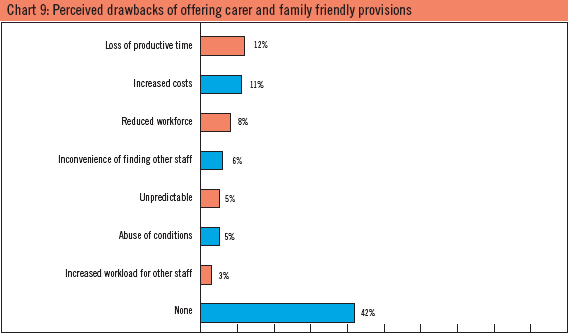
In line with SMEs' positive views on the benefits of offering carer and family friendly provisions to their employees, some 42 per cent felt that there were no counteracting drawbacks. Businesses with equal joint male and female operators were the most likely to feel that providing carer and family friendly provisions had no drawbacks, with 51 per cent nominating this response, which was closely followed by 48 per cent of predominantly female-operated businesses. This contrasted with those SMEs with predominantly male operators, of which 39 per cent felt that offering these provisions had no drawbacks for their business. SMEs in the accommodation, café and restaurant sector were most likely to believe that offering carer and family friendly provisions had no drawbacks for their business (64 per cent).
Overall the perceived drawbacks nominated by small businesses were relatively low in comparison to the benefits, with only two issues being nominated by more than ten per cent of SMEs: the loss of productive time and increased costs to the business.
A loss of productive time was most likely to be noted by businesses that were predominantly operated by females (15 per cent), followed by those with predominantly male operators (13 per cent), and least noted by those with equal joint female and male operators (nine per cent). It was most likely to be seen as a drawback by businesses in the finance and insurance sector (30 per cent) and the manufacturing sector (21 per cent), with businesses in the accommodation, café and restaurant sector least likely to nominate this as a drawback (three per cent).
The most significant drawbacks in this sector were seen to be the inconvenience of rearranging staff and the abuse of provisions (both nominated by five per cent of businesses in the sector). There was little difference between small and medium businesses on the top drawbacks, however medium businesses were almost three times as likely as small businesses to nominate the inconvenience of rearranging staff as a drawback (14 per cent compared to five per cent).
Barriers to SMEs offering carer and family friendly provisions

In general, the barriers and difficulties that SMEs reported facing in offering carer and family friendly provisions were similar in nature to many of the drawbacks that SMEs noted previously. Only 17 per cent of SMEs felt that they faced no barriers or difficulties in offering improved provisions to their employees.
SMEs that were operated equally by males and females were most likely to report facing no difficulties in offering carer and family friendly provisions (28 per cent). This compared to only 15 per cent of predominantly male-operated businesses that felt they faced no difficulties in offering these provisions. Businesses in the accommodation, cafe and restaurant sector were least likely to feel that there were barriers, with 33 per cent stating that they faced no difficulties in providing carer and family friendly provisions to their employees.
The main barrier that SMEs felt they faced in offering carer and family friendly provisions was overwhelmingly the increased costs that they believed these provisions would add to their business, a response given by 23 per cent of SMEs. Businesses in the cultural, recreational and personal services sector were most likely to be concerned about the cost of provisions, with 51 per cent of SMEs in that sector providing this response. This compared with only one per cent of SMEs in the finance and insurance sector. Small businesses were also more likely to be concerned about costs than medium businesses (24 per cent compared to 19 per cent).
Other difficulties that were noted by over 10 per cent of SMEs were the difficulties that a reduced workforce would cause; the inconvenience of re-arranging other staff; and the loss of productive time. All three of these issues were noted by 12 per cent of businesses. Whilst the reduced workforce issue was raised by similar proportions of male and female SME operators, the latter two issues were significantly more likely to be noted by those businesses that were predominantly operated by males.
The impact of carer and family friendly provisions on business performance
The Sensis® Business Index regularly tracks the performance of businesses every quarter. When one examines the confidence levels of businesses that offer their employees carer and family friendly provisions compared to those that do not in Chart 11, it can be seen that businesses offering provisions tended to report higher performance for most indicators.
The gap in performance indicators was most pronounced for sales and wages (30 percentage point difference each); profitability (29 percentage point difference); and prices (10 percentage point difference). On top of this, SMEs that provided carer and family friendly benefits were also more likely to export than those that did not (17 per cent compared to five per cent). The only indicator for which businesses offering their employees no provisions showed a higher level of performance was for capital expenditure.
However, as only three per cent of SMEs offered no provisions at all to their employees, analysis was also done examining how those SMEs performed who offered above average levels of provisions to their employees (see Chart 12). Overall, half of those SMEs with employees offered less than eight caring provisions. Comparing SMEs that offered up to and including seven provisions with SMEs that offered eight or more provisions it was found that SMEs that offered a large array of carer and family friendly provisions to their staff also reported very strong levels of performance, with all indicators rating significantly above average.
| SMEs offering employees provisions | SMEs offering no provisions | All SMEs | |
|---|---|---|---|
| Sales | +20% | -10% | +12% |
| Profitability | +15% | -14% | +9% |
| Capital expenditure | -2% | +3% | -1% |
| Employment | +3% | -2% | +1% |
| Wages | +21% | +9% | +14% |
| Prices | +18% | +0% | +16% |
| SMEs offering employees provisions | SMEs offering no provisions | All SMEs | |
|---|---|---|---|
| Sales | +26% | +12% | +12% |
| Profitability | +19% | +8% | +9% |
| Capital expenditure | +5% | -7% | -1% |
| Employment | +5% | +1% | +1% |
| Wages | +28% | +14% | +14% |
| Prices | +19% | +15% | +16% |
In interpreting this data, it is important to keep in mind the context of the operating environment for businesses at the time. The February 2006 Sensis® Business Index found that SMEs were operating at a relatively strong stage of the business cycle, having recovered from some concerns with increasing fuel prices the previous quarter. Indicators such as sales and profitability had recorded improvements, however employment, a lagging indicator, showed weaker performance in line with the weaker economic provisions recorded the previous quarter.
Caring responsibilities of SME operators
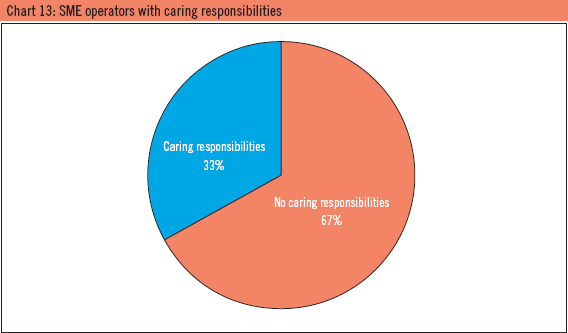
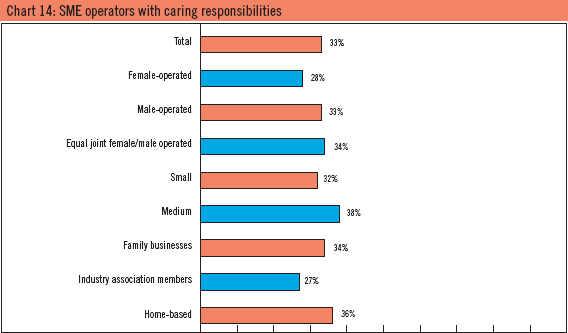
It is important to remember that SME operators not only provide provisions to enable their employees to meet their family responsibilities, they also have family responsibilities of their own. The survey found that, overall, some 33 per cent of SME operators themselves had caring responsibilities for either children, partners, parents or adult children with disabilities.
Whilst this varied to some extent with the demographics of the business, there was not a major difference for most categories of business. Operators of equal joint female and male businesses were slightly more likely than average to have caring responsibilities, with operators of predominantly female-operated businesses below average and predominantly male-operated businesses marginally below average. Operators of medium businesses were more likely than small business operators to have caring responsibilities, as were operators of family businesses and home-based businesses.
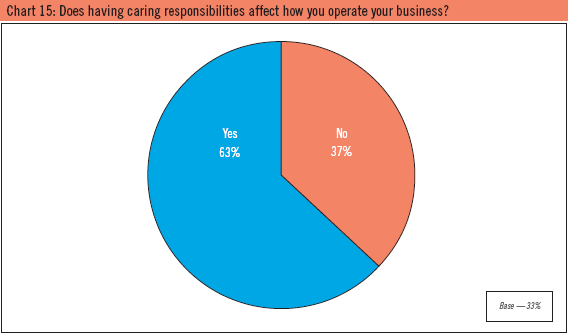
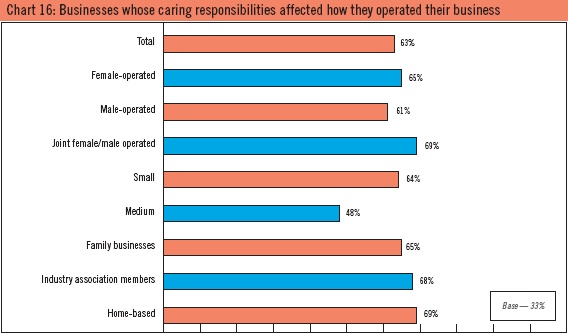
For those businesses that did have caring responsibilities, those responsibilities were more likely than not to have some form of impact on how they operated their business. This was the case for 63 per cent of business operators who had caring responsibilities. While for most categories of businesses there was no major variation in this result, the survey did find that operators of medium businesses who had caring responsibilities were far less likely than other business operators to report that their caring responsibilities affected how they operated their business. Home-based businesses and businesses with equal joint female and male operators were the most likely to report that their caring responsibilities affected how they operated their business, with some 69 per cent of operators who had caring responsibilities reporting that this was the case.
The main ways that the caring responsibilities of operators affected their business operations tended to be time related. There were two top perceptions of the impact of caring responsibilities on businesses: firstly, the constraint that it puts on the time that they could put into their business, including the hours that they could work and manage the business. This was very closely followed by having to have flexible business hours to enable them to work around their caring responsibilities.
Of these two impacts, male business operators were more likely to report that having caring responsibilities impacted on the hours that could be invested in working on and managing the business. Female business operators and joint female and male operators were more likely to report having to have flexible business hours as they tried to fulfil both caring and business responsibilities by juggling both.
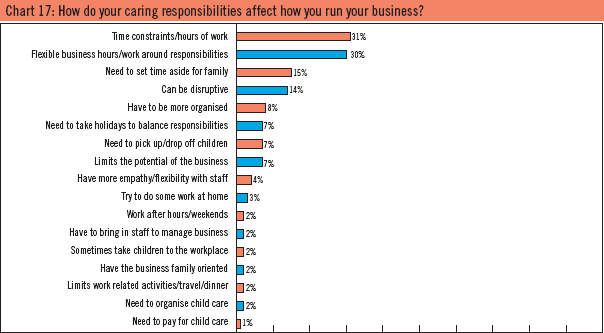
The second impact, that caring responsibilities required operators to have flexible business hours and work around their responsibilities, refl ected a slightly different perspective to the previous scenario. In this perspective, business operators reported trying to fulfil both sets of responsibilities, to their families and their business by juggling both. This response was given mostly by businesses with equal joint female and male operators, as well as those businesses that were predominantly operated by females. For both of these business demographics this was the top response.
It is also interesting to note that the caring responsibilities of some SME operators had an impact on how they viewed the caring responsibilities of their employees, with some operators who felt that their caring responsibilities affected how they ran their business reporting that it gave them empathy towards their employees' family situations.
Carer and family friendly provisions for staff attraction and retention
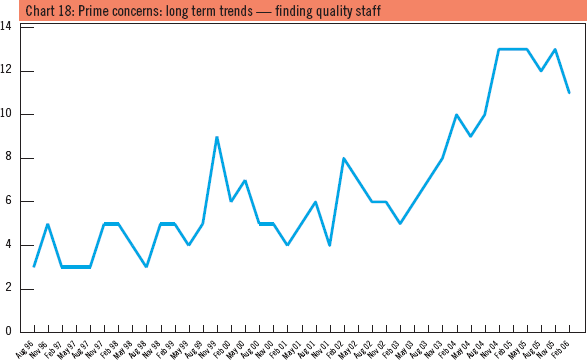
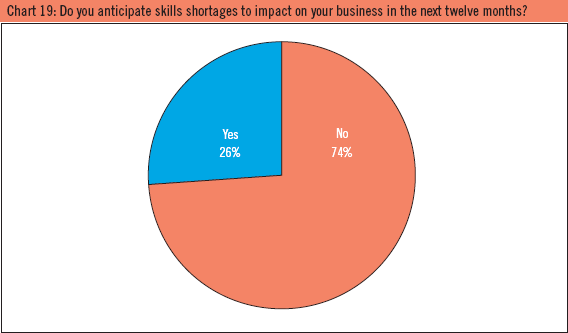
When looking at issues that have risen in importance for SMEs in the past year, it is hard to overlook the considerable increase in concern surrounding the issue of finding quality staff. This problem has increased to historically high levels in the past three years, having risen from five per cent in February 2003 to now being cited as a problem by 11 per cent of SME operators, after having peaked at 13 per cent in recent quarters.
The nature of this problem tends to vary depending on where a business is located and what industry it is in. In addition, it is important to recognise that this concern partly stems from current low rates of unemployment, leaving a smaller than average pool of potential employees from which SMEs can draw staff, as well as a longer term structural shift in employment, which has seen relative downward shifts in the proportion of students undertaking vocational education and training compared to increasing participation in tertiary education.
However, despite both the short and longer term causes of this situation, SMEs are not expecting any change in the near future. Overall, this survey found that over one quarter of SMEs expected to have skills shortages impact on their business in the next twelve months.
As mentioned earlier, the two most critical factors that increase the probability of a business facing a problem with finding quality staff are location and industry sector. These two factors were also highlighted when examining the demographics of businesses that were anticipating having problems in this area in the next twelve months. The highest level of anticipated skills shortage was recorded by SMEs located in the Northern Territory. SMEs in the Northern Territory have consistently been recording very high levels of difficulty in finding quality staff in recent years. Anticipated problems with skills shortages were highest in manufacturing, a sector which has been one of the hardest hit by staff shortages. This was followed by businesses in the accommodation, café and restaurant sector, which has been reporting difficulties particularly with staff retention in a highly transient sector. Other sectors which were above average included the retail sector, which has also been reporting problems with wage levels, and the building and construction sector, which has been reporting difficulties finding tradespeople.
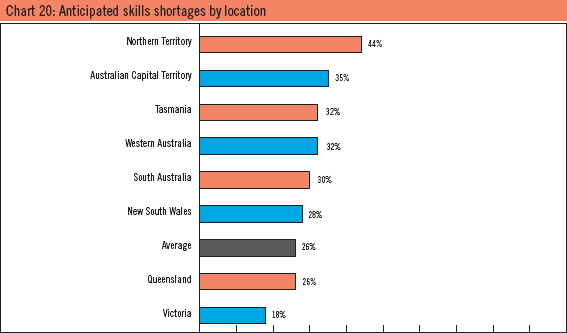
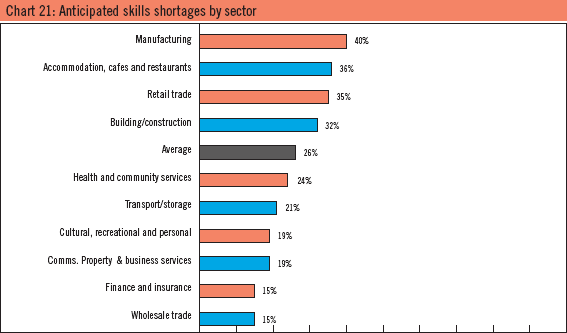
In a relatively competitive environment for employees, SMEs are under increasing pressure to provide competitive employment packages. Whilst for many SMEs it is difficult to compete with wage levels offered in larger organisations, it is possible to compete by offering increased flexibility. As this report has found, very few SMEs do not provide any carer and family friendly provisions for their employees, with most SME operators very flexible in the types of provisions that they provide. In addition, the vast majority of SME operators feel that providing such provisions is beneficial for their businesses. When asked directly, some 57 per cent of SME operators would look at changing working provisions in their business in order to either attract new employees or retain their current employees. Businesses that were predominantly operated by females were far more likely than other operator groups to be prepared to change their working provisions (62 per cent compared to 46 per cent). Medium businesses were also more likely to consider changing working arrangements than their smaller counterparts (79 per cent compared to 56 per cent). Home-based businesses showed one of the lowest levels of inclination towards encompassing any change to attract or retain employees (42 per cent).
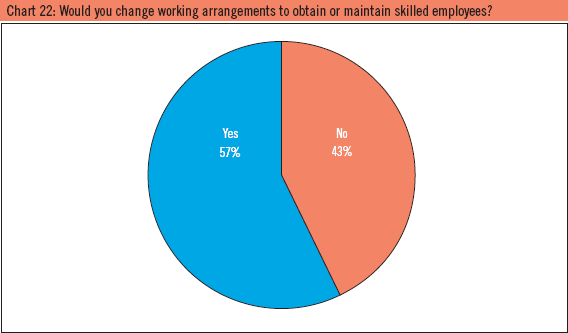
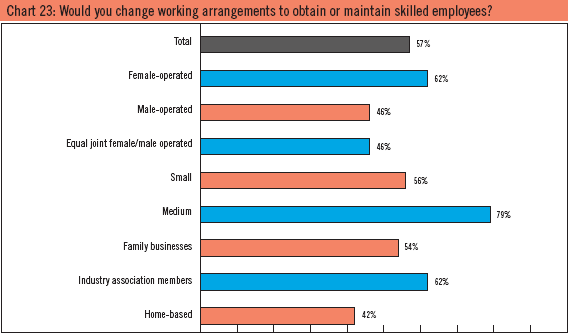
How SMEs provide carer and family friendly provisions
- Part-time work
- Working from home
- Job-sharing
- Flexible annual leave
- The ability to purchase additional annual leave
- Flexible start and finish times
- Paid parental leave
- Unpaid parental leave
- Paid adoption leave
- Unpaid adoption leave
- Carers leave to care for children
- Carers leave to care for another family member
- Unpaid emergency leave for casual employees
- Access to a telephone for family reasons
- The ability to bring children to work in an emergency
- The ability to bring an older person or person with a disability to work in an emergency
- Subsidy for child care
- Subsidy for elder care or care for a family member with a disability
- On-site child care
This section of the report examines each provision in detail, in particular looking at how SMEs provide the provision in their business. In particular, this section highlights the often informal nature of carer and family friendly provisions in SMEs, with many businesses shaping their provisions in response to the individual requirements of their employees, rather than relying on more formal structures such as awards or agreements. It should be remembered that Australian SMEs are bound by Australian legislative requirements as set out in the Australian Fair Pay and Conditions Standard in the Workplace Relations Act 1996. By law, no workplace agreement or contract can provide conditions which are less than those in the Standard. In this context, it should be noted that the results in this report are self-reported by the SME operators who took part in the Sensis® Business Index survey in January and February 2006.
Part-time work
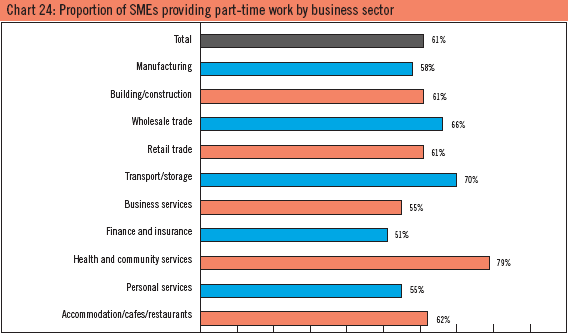
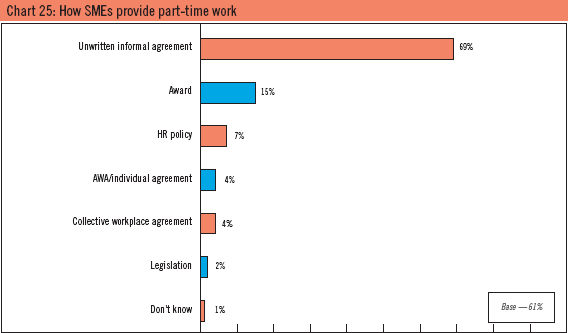
Part-time work was a provision that was offered by 61 per cent of SMEs. It was significantly more likely to be offered by SMEs in regional areas (67 per cent); by businesses that were predominantly operated by females (73 per cent); by businesses in the health and community services sector (79 per cent); and by medium businesses (71 per cent).
Overall, some 43 per cent of SMEs reported that employees had used the ability to work part-time in the past twelve months, a take-up rate of 70 per cent of businesses in which it was offered. Part-time work was most likely to be used in SMEs that were operated predominantly by females (64 per cent); in businesses in the health and community services sector (71 per cent); and in medium businesses (60 per cent).
Businesses reported that part-time work was most likely to be provided in unwritten informal agreements, which was the case for 69 per cent of the businesses that offered this provision. Other methods of provision were relatively small by comparison, with awards being the next most used method, nominated by 15 per cent of businesses that had part-time work.
Working from home
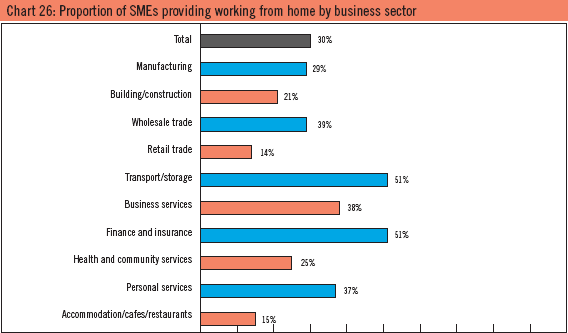
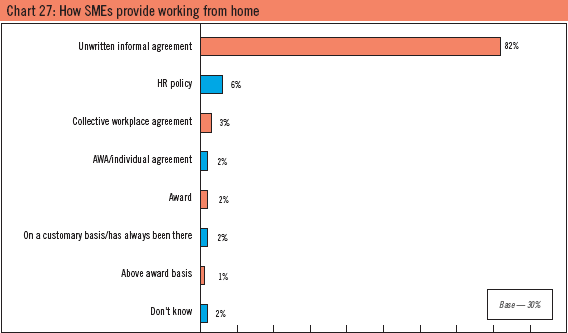
The ability for employees to work from home was a provision that was offered by 30 per cent of SMEs. It was more likely to be offered by SMEs in metropolitan areas (33 per cent); by businesses that were predominantly operated by males (31 per cent); by businesses in the transport and storage and finance and insurance sectors (51 per cent); and by medium businesses (42 per cent).
Overall, some 25 per cent of SMEs reported that employees had used the ability to work from home in the past twelve months, a take-up rate of 83 per cent of businesses in which it was offered. Working from home was most likely to be used in SMEs in metropolitan areas (28 per cent); SMEs that were operated predominantly by males (28 per cent); in businesses in the finance and insurance sector (55 per cent); and in medium businesses (39 per cent).
The ability to work from home was most likely to be reported as provided in unwritten informal agreements, which was the case for 82 per cent of the businesses that offered this provision. Other methods of provision were relatively small by comparison, with human resources policies being the next most used method, nominated by six per cent of businesses that allowed employees to work from home.
Job sharing
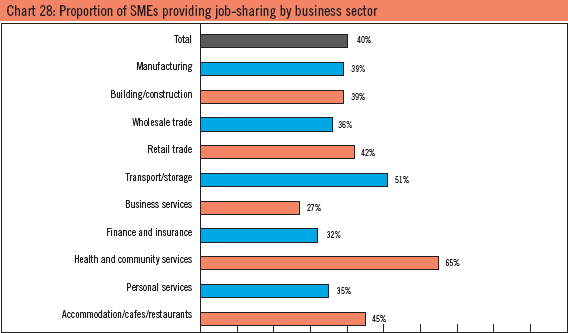
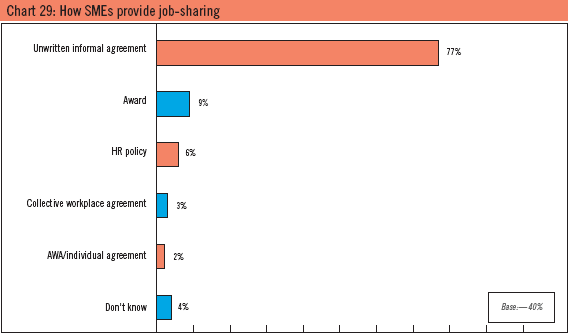
Job-sharing was a provision that was offered by 40 per cent of SMEs. It was significantly more likely to be offered by SMEs in regional areas (49 per cent); by businesses that were predominantly operated by females (53 per cent); by businesses in the health and community services sector (65 per cent); and by medium businesses (44 per cent).
Overall, some 24 per cent of SMEs reported that employees had used job-sharing in the past twelve months, a take-up rate of 60 per cent of businesses in which it was offered. Job-sharing was most likely to be used in SMEs in regional areas (29 per cent); SMEs that were operated predominantly by females (28 per cent); in businesses in the health and community services sector (55 per cent); and in medium businesses (32 per cent).
Job-sharing was most likely to be reported as provided in unwritten informal agreements, which was the case for 77 per cent of the businesses which offered this provision. Other methods of provision were relatively small by comparison, with awards being the next most used method, nominated by nine per cent of businesses that allowed employees to job-share.
Flexible annual leave
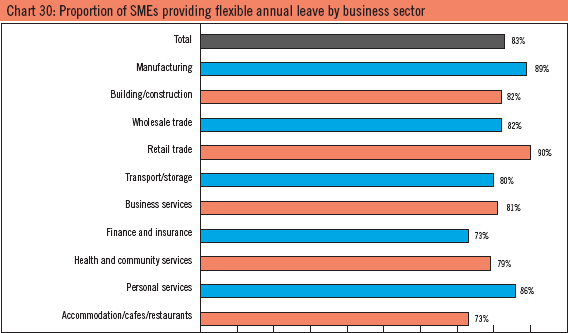
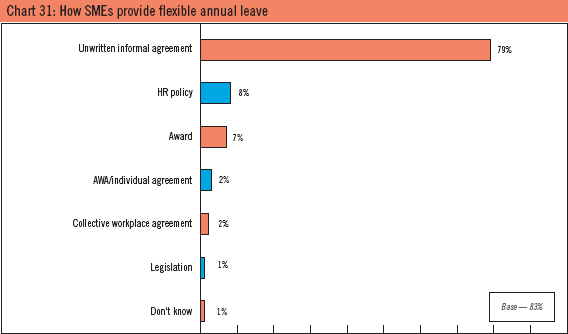
Flexible annual leave, with respect to the ability of employees to choose the timing and have the ability to use single days if desired, was a provision that was offered by 83 per cent of SMEs. It was more likely to be offered by SMEs in metropolitan areas (85 per cent); by businesses that were predominantly operated by females (86 per cent); by businesses in the retail sector (90 per cent); and by medium businesses (91 per cent).
Overall, some 73 per cent of SMEs reported that employees had used flexible annual leave in the past twelve months, a take-up rate of 88 per cent of businesses in which it was offered. Flexible annual leave was most likely to be used in SMEs in metropolitan areas (76 per cent); SMEs that were operated predominantly by females (83 per cent); in businesses in the retail sector (79 per cent); and in medium businesses (86 per cent).
Flexible annual leave was most likely to be reported as provided in unwritten informal agreements, which was the case for 79 per cent of the businesses that offered this provision. Other methods of provision were relatively small by comparison, with human resources policies being the next most used method, nominated by eight per cent of businesses that had flexible annual leave.
The ability to purchase additional annual leave
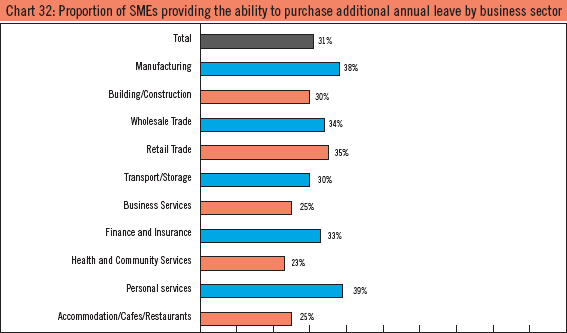
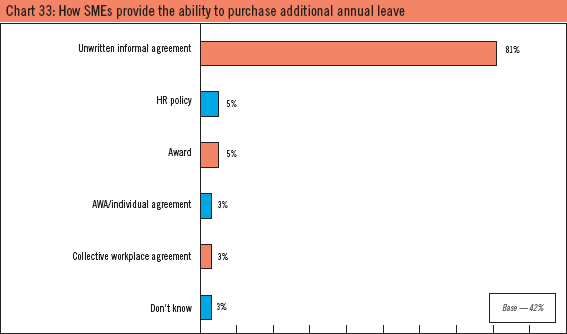
The ability to purchase additional annual leave was a provision that was offered by 31 per cent of SMEs. It was more likely to be offered by SMEs in metropolitan areas (32 per cent); by businesses that were predominantly operated by males (32 per cent); by businesses in the cultural, recreational and personal services sector (39 per cent); by small businesses (31 per cent); and by family businesses (33 per cent).
Overall, some 14 per cent of SMEs reported that employees had used the ability to purchase additional annual leave in the past twelve months, a take-up rate of 45 per cent of businesses in which it was offered. The ability to purchase additional annual leave was most likely to be used in SMEs that were operated predominantly by females (20 per cent); in businesses in the retail sector (23 per cent); in small businesses (16 per cent) and in family businesses (16 per cent).
The ability to purchase additional annual leave was most likely to be reported as provided in unwritten informal agreements, which was the case for 81 per cent of the businesses that offered this provision. Other methods of provision were relatively small by comparison, with human resources policies and awards being the next most used methods, nominated by five per cent each of businesses that had the ability to purchase additional annual leave.
Flexible start and finish times
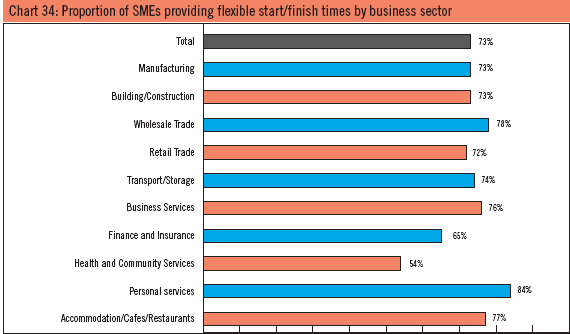
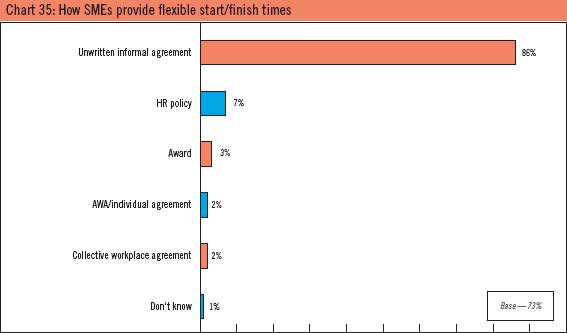
Flexible start and finish times were a provision offered by 73 per cent of SMEs. It was more likely to be offered by businesses that were predominantly operated by females (77 per cent); by businesses in the cultural, recreational and personal services sector (84 per cent); and by medium businesses (77 per cent).
Overall, some 70 per cent of SMEs reported that employees had used flexible start and finish times in the past twelve months, a take-up rate of 96 per cent of businesses in which it was offered, the highest take-up rate of any provision. Flexible start and finish times were most likely to be used in SMEs in regional areas (71 per cent); SMEs that were operated predominantly by females (73 per cent); in businesses in the retail sector (79 per cent); and in medium businesses (86 per cent).
Flexible start and finish times were most likely to be reported as provided in unwritten informal agreements, which was the case for 86 per cent of the businesses that offered this provision. Other methods of provision were relatively small by comparison, with human resources policies being the next most used method, nominated by seven per cent of businesses that had flexible start and finish times.
Paid parental leave
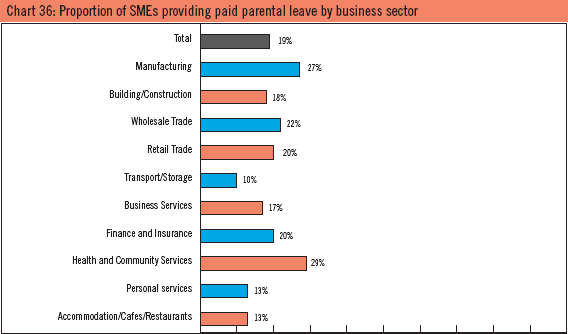
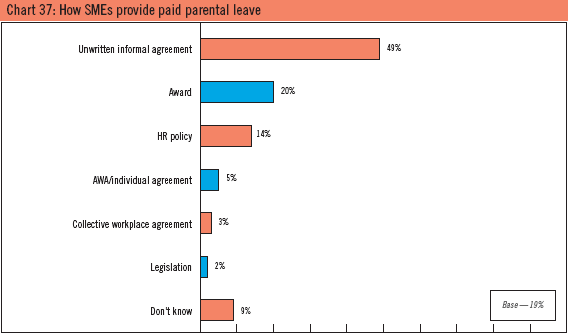
Paid parental leave was a provision that was offered by 19 per cent of SMEs. It was more likely to be offered by SMEs in metropolitan areas (20 per cent); by businesses that had equal joint female and male operators (24 per cent); by businesses in the health and community services sector (29 per cent); and by medium businesses (39 per cent).
Overall, some six per cent of SMEs reported that employees had used paid parental leave in the past twelve months, a take-up rate of 32 per cent of businesses in which it was offered. Paid parental leave was most likely to be used in businesses in the health and community services sector (12 per cent); and in medium businesses (27 per cent).
Paid parental leave was most likely to be reported as provided in unwritten informal agreements, which was the case for 49 per cent of the businesses that offered this provision. Awards were the next most used method, nominated by 20 per cent of businesses that had paid parental leave, followed by human resources policies in 14 per cent of SMEs.
Unpaid parental leave
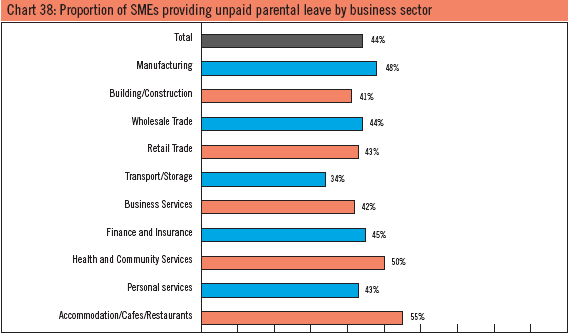
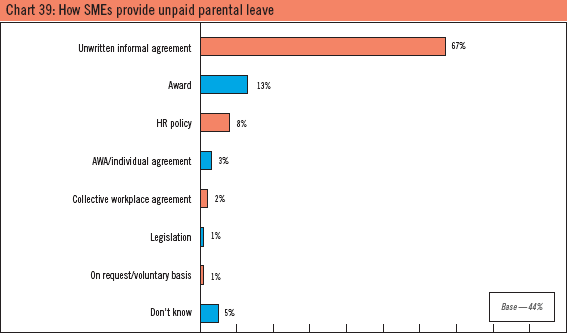
Unpaid parental leave was a provision that was offered by 44 per cent of SMEs. It was significantly more likely to be offered by SMEs in the accommodation, cafes and restaurant sector (55 per cent); and by medium businesses (76 per cent).
Overall, some 14 per cent of SMEs reported that employees had used unpaid parental leave in the past twelve months, a take-up rate of 32 per cent of businesses in which it was offered. Unpaid parental leave was most likely to be used in SMEs that were operated predominantly by females (17 per cent); in businesses in the cultural, recreational and personal services sector (22 per cent); and in medium businesses (44 per cent).
Unpaid parental leave was most likely to be reported as provided in unwritten informal agreements, which was the case for 67 per cent of the businesses that offered this provision. Other methods of provision were awards, which were nominated by 13 per cent of businesses that had unpaid parental leave.
It should be noted that the Australian Fair Pay and Conditions Standard provides for a maximum of 52 weeks of unpaid parental leave, shared between both parents at the time of the birth of a child. The parental leave provisions apply to all full-time, part-time and eligible casual employees with at least 12 months continuous service with their current employer.
Paid adoption leave
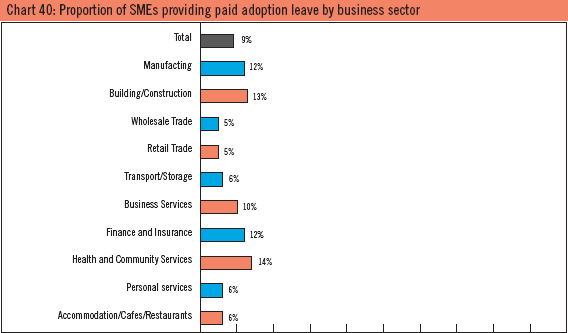
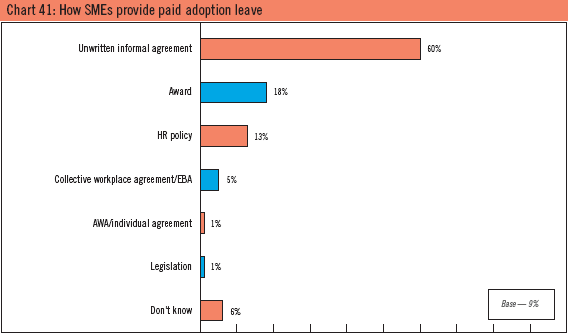
Paid adoption leave was a provision that was offered by nine per cent of SMEs. It was more likely to be offered by businesses that had equal joint female and male operators (16 per cent); by businesses in the health and community services sector (14 per cent); and by medium businesses (19 per cent).
Overall, only one per cent of SMEs reported that employees had used paid adoption leave in the past twelve months, a take-up rate of 11 per cent of businesses in which it was offered.
Paid adoption leave was most likely to be reported as provided in unwritten informal agreements, which was the case for 60 per cent of the businesses that offered this provision. Awards were the next most used method, nominated by 18 per cent of businesses that had paid adoption leave, followed by human resources policies in 13 per cent of SMEs.
Unpaid adoption leave
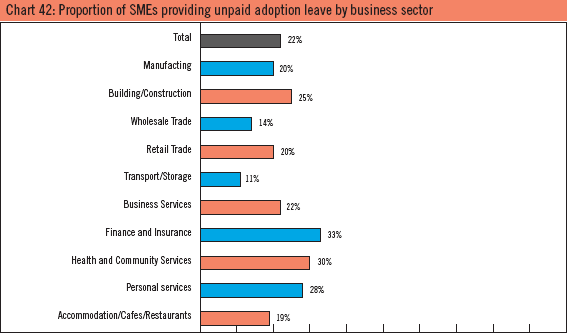
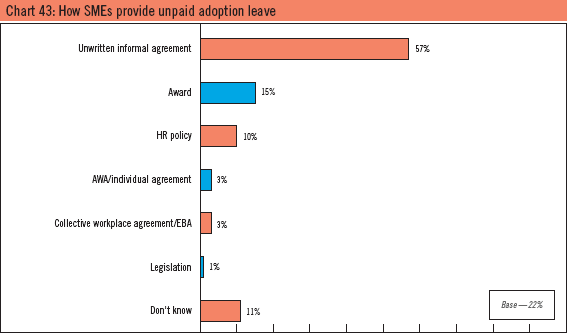
Unpaid adoption leave was a provision that was offered by 22 per cent of SMEs. It was more likely to be offered by businesses with equal joint female and male operators (28 per cent); by businesses in the finance and insurance sector (33 per cent); and by medium businesses (27 per cent).
Again, only one per cent of SMEs reported that employees had used unpaid adoption leave in the past twelve months, a take-up rate of five per cent of businesses in which it was offered.
Unpaid adoption leave was most likely to be reported as provided in unwritten informal agreements, which was the case for 57 per cent of the businesses that offered this provision. Awards were the next most used method, nominated by 15 per cent of businesses that had unpaid adoption leave, followed by human resource policies in 10 per cent of SMEs.
It should be noted that the Australian Fair Pay and Conditions Standard provides for a maximum of 52 weeks of unpaid parental leave, shared between both parents at the time of the adoption of a child under five years of age. The parental leave provisions apply to all full-time, part-time and eligible casual employees with at least 12 months continuous service with their current employer.
Carers leave to care for children
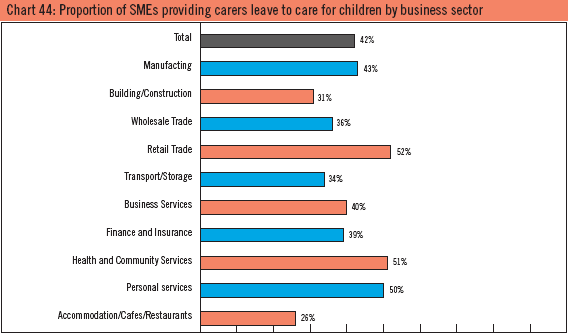
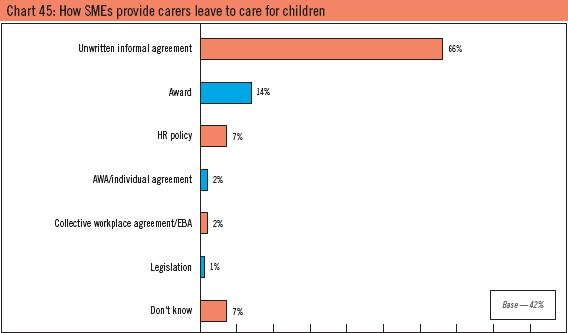
Carers leave to care for children was a provision that was offered by 42 per cent of SMEs. It was more likely to be offered by SMEs in regional areas (32 per cent); by businesses in the retail trade sector (52 per cent); and by medium businesses (63 per cent).
Overall, some 22 per cent of SMEs reported that employees had used carers leave to care for children in the past twelve months, a take-up rate of 52 per cent of businesses in which it was offered. Carers leave to care for children was most likely to be used in SMEs that were operated predominantly by females (29 per cent); in businesses in the health and community services sector (37 per cent); and in medium businesses (50 per cent).
The ability to use carers leave to care for children was most likely to be reported as provided in unwritten informal agreements, which was the case for 66 per cent of the businesses that offered this provision. Other methods of provision were awards, nominated by 14 per cent of businesses that had carers leave to care for children.
Carers leave to care for another family member
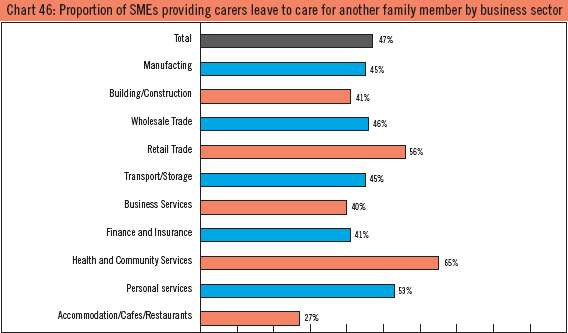
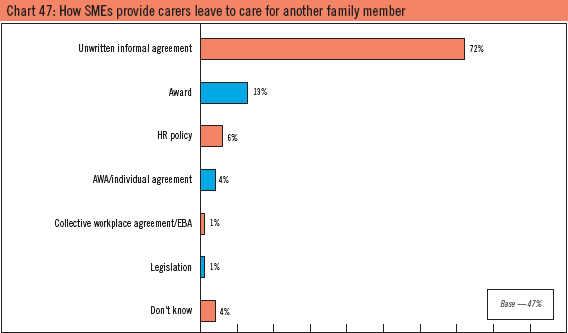
Carers leave to care for another family member, such as a partner, parent or adult child with a disability, was a provision that was offered by 47 per cent of SMEs. It was more likely to be offered by SMEs in regional areas (50 per cent); by businesses that had equal joint female and male operators (52 per cent); by businesses in the health and community services sector (65 per cent); and by medium businesses (63 per cent).
Overall, some 20 per cent of SMEs reported that employees had used carers leave to care for another family member in the past twelve months, a take-up rate of 43 per cent of businesses in which it was offered. Carers leave to care for other family members was most likely to be used in businesses in the manufacturing sector (29 per cent); and in medium businesses (43 per cent).
Carers leave to care for another family member was most likely to be reported as provided in unwritten informal agreements, which was the case for 72 per cent of the businesses that offered this provision. Other methods of provision included awards, which were nominated by 13 per cent of businesses that had carers leave to care for other family members.
Unpaid emergency leave for casual employees
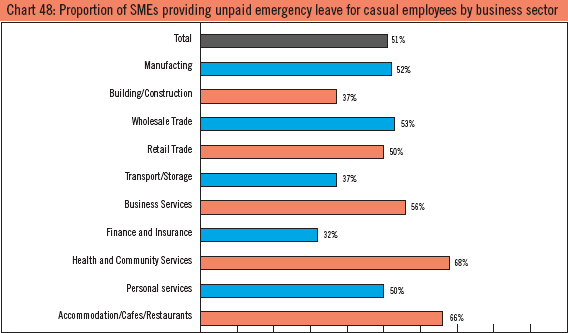
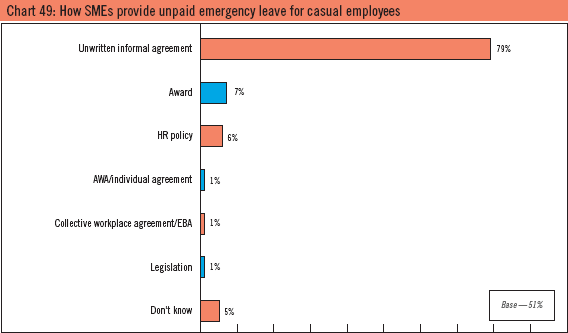
Unpaid emergency leave for casual employees was a provision that was offered by 51 per cent of SMEs. It was more likely to be offered by SMEs in regional areas (52 per cent); by businesses that were predominantly operated by females (62 per cent); by businesses in the health and community services sector (68 per cent); and by medium businesses (58 per cent).
Overall, some 25 per cent of SMEs reported that casual employees had used unpaid emergency leave in the past twelve months, a take-up rate of 49 per cent of businesses in which it was offered. Unpaid emergency leave for casual employees was most likely to be used in SMEs that were located in regional areas (32 per cent); operated predominantly by females (40 per cent); in businesses in the accommodation, cafes and restaurant sector (59 per cent); and in medium businesses (34 per cent).
Unpaid emergency leave for casual employees was most likely to be reported as provided in unwritten informal agreements, which was the case for 79 per cent of the businesses that offered this provision. Other methods of provision were relatively small by comparison, with awards and human resources policies being the next most used methods by businesses that had unpaid emergency leave for casual employees.
It should be noted that the Australian Fair Pay and Conditions Standard provides ten days paid personal/ carer’s leave per year, with casual employees or employees who have not accrued sick leave able to access two days unpaid “emergency” leave per year.
Access to a telephone for family reasons
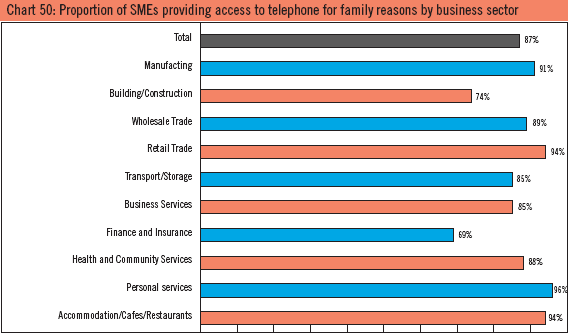
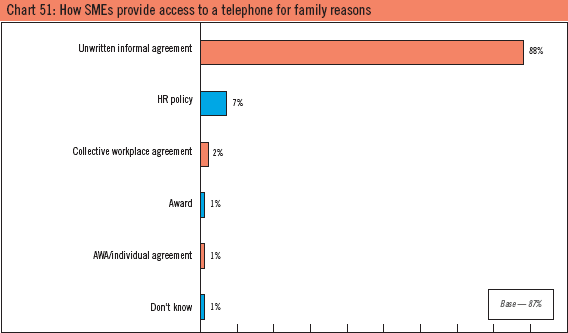
Access to a telephone for family reasons was a provision that was offered by 87 per cent of SMEs. It was more likely to be offered by SMEs in metropolitan areas (88 per cent); by businesses that were predominantly operated by females (92 per cent); by businesses in the cultural, recreational and personal services sector (96 per cent); and by medium businesses (94 per cent).
Overall, some 81 per cent of SMEs reported that employees had used their access to a telephone for family reasons in the past twelve months, a take-up rate of 93 per cent of businesses in which it was offered. Access to a telephone for family reasons was most likely to be used in SMEs that were operated predominantly by females (90 per cent); in businesses in the cultural, recreational and personal services sector (96 per cent); and in medium businesses (90 per cent).
Access to a telephone for family reasons was most likely to be reported as provided in unwritten informal agreements, which was the case for 88 per cent of the businesses that offered this provision. Other methods of provision were relatively small by comparison, with human resources policies being the next most used method, nominated by seven per cent of businesses that had access to a telephone for family reasons.
The ability to bring children to work in an emergency
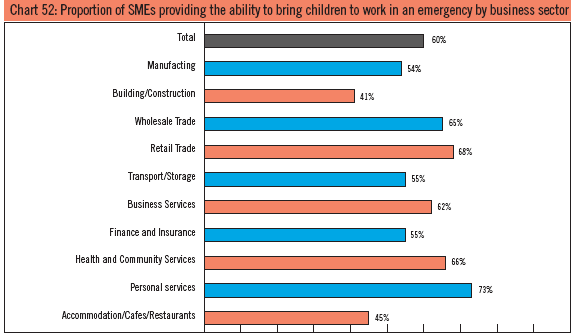
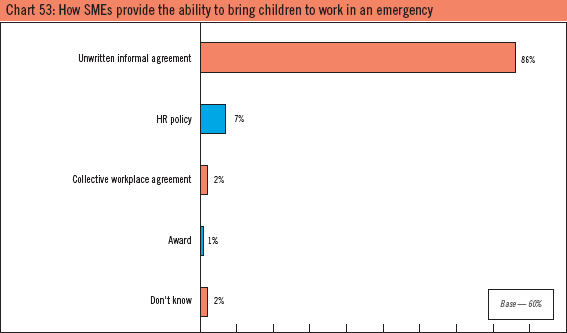
The ability to bring children to work in an emergency was a provision that was offered by 60 per cent of SMEs. It was more likely to be offered by businesses that were predominantly operated by females (66 per cent); by businesses in the cultural, recreational and personal services sector (73 per cent); and by small businesses (60 per cent).
Overall, some 37 per cent of SMEs reported that employees had used the ability to bring children to work in an emergency in the past twelve months, a take-up rate of 62 per cent of businesses in which it was offered. The ability to bring children to work in an emergency was most likely to be used in SMEs that were operated predominantly by females (45 per cent); in businesses in the health and community services sector (48 per cent); in medium businesses (47 per cent) and in family businesses (37 per cent).
The ability to bring children to work in an emergency was most likely to be reported as provided in unwritten informal agreements, which was the case for 86 per cent of the businesses that offered this provision. Other methods of provision were relatively small by comparison, with human resources policies being the next most used method, nominated by seven per cent of businesses that allowed their employees to bring their children to work in an emergency.
The ability to bring an older person or a person with a disability to work in an emergency
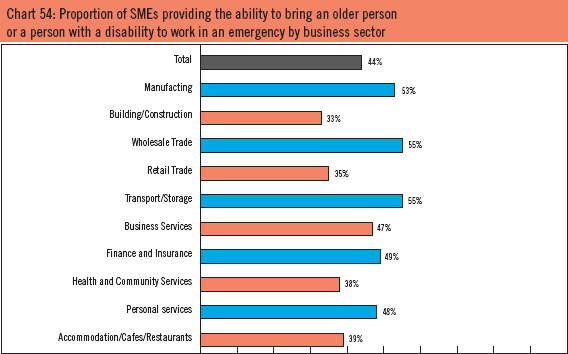
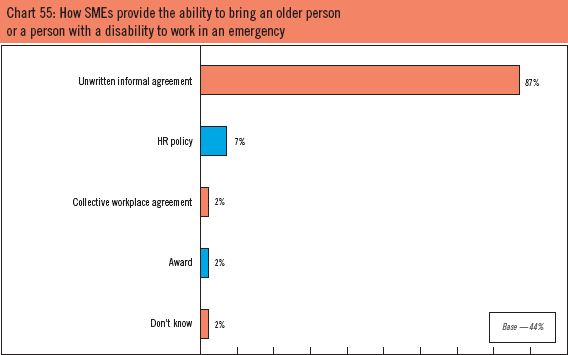
The ability to bring an older person or person with a disability to work in an emergency was a provision that was offered by 44 per cent of SMEs. It was more likely to be offered by SMEs in regional areas (46 per cent); by businesses that were predominantly operated by females (54 per cent); by businesses in the wholesale trade and transport and storage sectors (55 per cent each); and by small businesses (44 per cent).
Overall, some five per cent of SMEs reported that employees had used the ability to bring an older person or person with a disability to work in an emergency in the past twelve months, a take-up rate of 11 per cent of businesses in which it was offered. The ability to bring an older person or person with a disability to work in an emergency was most likely to be used in SMEs that were operated predominantly by females (14 per cent); in businesses in the wholesale trade sector (11 per cent); and in medium businesses (six per cent).
The ability to bring an older person or person with a disability to work in an emergency was most likely to be reported as provided in unwritten informal agreements, which was the case for 87 per cent of the businesses that offered this provision. Other methods of provision were relatively small by comparison, with human resources policies being the next most used method by businesses that had this provision.
Subsidy for child care
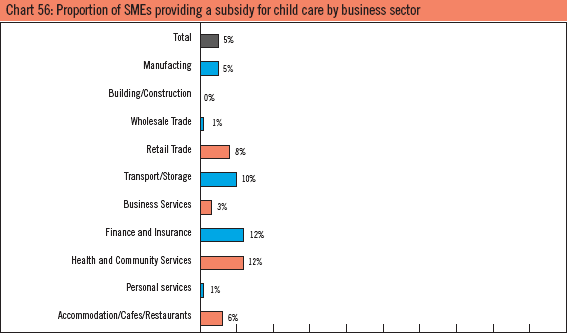
A subsidy for child care was a provision that was offered by five per cent of SMEs. It was more likely to be offered by SMEs that were predominantly operated by females (seven per cent); by businesses in the finance and insurance and health and community services sectors (12 per cent each); and by medium businesses (eight per cent).
Overall, only two per cent of SMEs reported that employees had used a subsidy for child care in the past twelve months, a take-up rate of 40 per cent of businesses in which it was offered. A subsidy for child care was most likely to be used in SMEs that were operated predominantly by females (five per cent); in businesses in the health and community services sector (eight per cent); and in medium businesses (four per cent).
A subsidy for child care was most likely to be reported as provided in unwritten informal agreements, which was the case for 71 per cent of the businesses that offered this provision. Other methods of provision were relatively small by comparison.
Subsidy for elder care or care for a family member with a disability
A subsidy for elder care or for care for a family member with a disability was a provision that was offered by only two per cent of SMEs. It was more likely to be offered by SMEs in metropolitan areas (three per cent); by businesses in the finance and insurance sector (10 per cent); by medium businesses (three per cent); and by family businesses (three per cent).
Overall, only negligible numbers of SMEs reported that employees had used a subsidy for elder care or care for a family member with a disability in the past twelve months.
A subsidy for elder care for care for a family member with a disability was most likely to be reported as provided in unwritten informal agreements, which was the case for 83 per cent of the businesses that offered this provision. Other methods of provision were relatively small by comparison, with collective workplace agreements being the next most used method, nominated by three per cent of businesses that provided a subsidy for elder care or for care for a family member with a disability.
On-site child care
On-site child care was a provision that was offered by five per cent of SMEs. It was more likely to be offered by SMEs in regional areas (seven per cent); by businesses that were predominantly operated by females (15 per cent); by businesses in the health and community services sector (21 per cent); by small businesses (six per cent); by home-based businesses (nine per cent); and by family businesses (six per cent).
Overall, some three per cent of SMEs reported that employees had used on-site child care in the past twelve months, a take-up rate of 60 per cent of businesses in which it was offered. On-site child care was most likely to be used in SMEs that were operated predominantly by females (14 per cent); in businesses in the health and community services sector (18 per cent); and in medium businesses (four per cent).
On-site child care was most likely to be reported as provided in unwritten informal agreements, which was the case for 83 per cent of the businesses that offered this provision. Other methods of provision were relatively small by comparison, with collective workplace agreements being the next most used method, nominated by five per cent of businesses that had on-site child care.
Conclusion
The research has found that many SMEs are achieving positive outcomes for their employees and their business by offering a broad range of family friendly provisions.
SME operators reported signifi cant business benefits from offering carer and family friendly provisions, including: less staff turnover; more flexibility for staff; increased productivity; a better working environment; and happier employees. These claims were supported by a correlation between businesses providing access to family friendly provisions and improved business performance, particularly in the areas of sales and profitability. In addition, SMEs providing above average levels of provisions were more likely than average to have increased the size of their workforce in the preceding quarter, and were much more likely to have increased their workforce than SMEs that did not offer any provisions to their employees.
Taken together, these findings support the existence of a clear business case for SMEs to provide carer and family friendly provisions to their employees. Whilst loss of productive time and associated costs were seen as drawbacks by some SMEs, in most instances operators noted that there were positive business benefi ts in being able to provide these provisions to their employees.
The survey responses suggest that the smaller size of SMEs in many cases facilitates a more flexible approach to offering provisions. In contrast to larger organisations, the operators and employees of SMEs often work closely together and in many cases have the flexibility to offer conditions beyond the minimum statutory provisions for employees. This can be seen not only in the range of provisions offered by SMEs but also in the informal way in which these are provided. Informal and unwritten agreements between employers and employees were by far the overwhelming way in which flexible working provisions were provided by SMEs.
It is interesting to note that many SME operators have caring responsibilities themselves. This was found to have an important impact on how they manage their businesses and balance completing priorities. Many SME operators had to shape their business hours around their family responsibilities or try to flexibly balance work and family at the same time.
Last updated:
